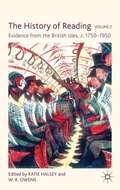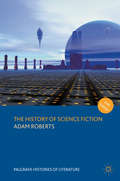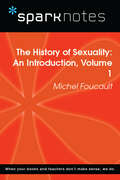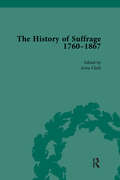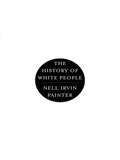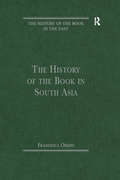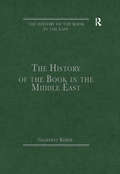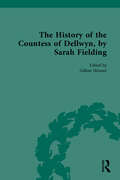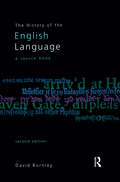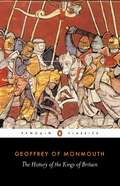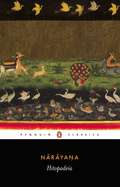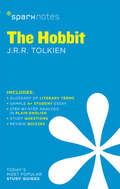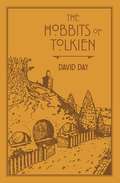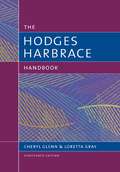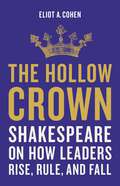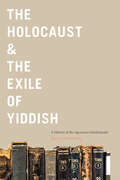- Table View
- List View
The History of Reading, Volume 1: International Perspectives, c. 1500–1990
by Shafquat Towheed W. R. OwensThe History of Reading, Volume 1: International Perspectives, c. 1500–1990 by Shafquat Towheed and W. R. Owens.
The History of Reading, Volume 2: Evidence from the British Isles, c.1750–1950
by W. R. Owens Katie Halsey'Reading has a history. But how can we recover it?' This volume brings together original research essays focusing on the history of reading in the British Isles, using evidence ranging from library records to Mass Observation surveys to highlight the social factors that influence a seemingly private, individual activity.
The History of Science Fiction
by Adam RobertsThis book is the definitive critical history of science fiction. The 2006 first edition of this work traced the development of the genre from Ancient Greece and the European Reformation through to the end of the 20th century. This new 2nd edition has been revised thoroughly and very significantly expanded. An all-new final chapter discusses 21st-century science fiction, and there is new material in every chapter: a wealth of new readings and original research. The author's groundbreaking thesis that science fiction is born out of the 17th-century Reformation is here bolstered with a wide range of new supporting material and many hundreds of 17th- and 18th-century science fiction texts, some of which have never been discussed before. The account of 19th-century science fiction has been expanded, and the various chapters tracing the twentieth-century bring in more writing by women, and science fiction in other media including cinema, TV, comics, fan-culture and other modes.
The History of Science Fiction and Its Toy Figurines
by Luigi Toiati"This eye-opening book deserves a spot on the bookshelves of anyone who not only enjoys collecting, but also has a great interest in all facets of the history of our hobby." — Toy Soldier Collector Science fiction, as the name suggests, is the combination of science and fantasy. In addition to a literary form, it also encompasses film, TV, comics, toys and our beloved toy astronauts, or other figures such as aliens, monsters and other playable genres. The term science fiction was coined by publisher Hugo Gernsbach around the first decades of the last century to refer to the predominantly 'space' adventures covered in his magazines. Space invaded radio, cinema, TV, and consequently for a long time toy figurines were predominantly space-related, later evolving into other themes. This lavishly illustrated book covers both the history of literary science fiction, following in the footsteps of contemporary official criticism, and toy figurines inspired by science fiction. You will also find several other themes, such as the link between science fiction figures and cinema, radio, TV, comics, and more. Luigi Toiati offers to both guide the reader on an often-nostalgic walk through science fiction in all its various forms, and to describe the figurines and brands associated with it.
The History of Sexuality: An Introduction, Volume 1 (SparkNotes Philosophy Guide)
by SparkNotesThe History of Sexuality: An Introduction, Volume 1 (SparkNotes Philosophy Guide) Making the reading experience fun! SparkNotes Philosophy Guides are one-stop guides to the great works of philosophy–masterpieces that stand at the foundations of Western thought. Inside each Philosophy Guide you&’ll find insightful overviews of great philosophical works of the Western world.
The History of Suffrage, 1760-1867 Vol 6
by Sarah Richardson Anna ClarkThis work brings together key texts drawn from the history of suffrage advocacy and agitation. The whole issue of voting rights and representation is shown to be anchored firmly in the wider political culture of Britain and Ireland as well as the Empire as a whole. Volume 6 covers texts from 1860 to 1873.
The History of Thyssen: Family, Industry and Culture in the 20th Century
by Günther Schulz Margit Szöllösi-JanzeAs a result of a multi-volume research project, funded by the Thyssen Foundations (Stiftung zur Industriegeschichte Thyssen and Fritz Thyssen Stiftung), ten books were published that served to greatly advance the available knowledge on the Thyssen family and their companies. The results of this project are summarized in this volume which provides both an explanation of how the project was conceptualized and executed and a detailed case study of a family and their business during the late-nineteenth and twentieth centuries. It explains the development of both whilst addressing issues such as patriarchal succession; gender roles in the family; wealthy lifestyles in international communities of aristocrats and diplomats; operating across national legislation, institutions, and policies; and discussions of labor and capital. In doing so it connects corporate and family history to provide an all-inclusive view of the development of a business.
The History of Tom Jones
by Henry FieldingA foundling of mysterious parentage brought up by Mr Allworthy on his country estate, Tom Jones is deeply in love with the seemingly unattainable Sophia Western, the beautiful daughter of the neighbouring squire - though he sometimes succumbs to the charms of the local girls. But when his amorous escapades earn the disapproval of his benefactor, Tom is banished to make his own fortune. Sophia, meanwhile, is determined to avoid an arranged marriage to Allworthy's scheming nephew and escapes from her rambunctious father to follow Tom to London.
The History of White People
by Nell Irvin PainterA New York Times bestseller: "This terrific new book . . . [explores] the 'notion of whiteness,' an idea as dangerous as it is seductive."--Boston Globe Telling perhaps the most important forgotten story in American history, eminent historian Nell Irvin Painter guides us through more than two thousand years of Western civilization, illuminating not only the invention of race but also the frequent praise of "whiteness" for economic, scientific, and political ends. A story filled with towering historical figures, The History of White People closes a huge gap in literature that has long focused on the non-white and forcefully reminds us that the concept of "race" is an all-too-human invention whose meaning, importance, and reality have changed as it has been driven by a long and rich history of events.
The History of Zonaras: From Alexander Severus to the Death of Theodosius the Great
by Thomas Banchich Eugene LaneWhile an exile from Constantinople, the twelfth-century Byzantine functionary and canonist John Zonaras culled earlier chronicles and histories to compose an account of events from creation to the reign of Alexius Comnenus. For topics where his sources are lost or appear elsewhere in more truncated form, his testimony and the identification of the texts on which he depends are of critical importance. For his account of the first two centuries of the Principate, Zonaras employed now-lost portions of Cassius Dio. From the point where Dio’s History ended, to the reign of Theodosius the Great (d. 395), he turned to other sources to produce a uniquely full historical narrative of the critical years 235-395, making Books XII.15-XIII.19 of the Epitome central to the study of both late Roman history and late Roman and Byzantine historiography. This key section of the Epitome, together with Zonaras’ Prologue, here appears in English for the first time, both complemented by a historical and historiographical commentary. A special feature of the latter is a first-ever English translation of a broad range of sources which illuminate Zonaras’ account and the historiographical traditions it reflects. Among the authors whose newly translated works occupy a prominent place in the commentary are George Cedrenus, George the Monk, John of Antioch, Peter the Patrician, Symeon Magister, and Theodore Scutariotes. Specialized indices facilitate the use of the translations and commentary alike. The result is an invaluable guide and stimulus to further research for scholars and students of the history and historiography of Rome and Byzantium.
The History of the Book in East Asia (The History of the Book in the East)
by Cynthia BrokawThe history of the book in East Asia is closely linked to problems of language and script, problems which have also had a profound impact on the technology of printing and on the social and intellectual impact of print in this area. This volume contains key readings on the history of printed books and manuscripts in China, Korea and Japan and includes an introduction which provides an overview of the history of the book in East Asia and sets the readings in their context.
The History of the Book in South Asia (The History of the Book in the East)
by Francesca OrsiniThe History of the Book in South Asia covers not only the various modern states that make up South Asia today but also a multitude of languages and scripts. For centuries it was manuscripts that dominated book production and circulation, and printing technology only began to make an impact in the late eighteenth century. Print flourished in the colonial period and in particular lithographic printing proved particularly popular in South Asia both because it was economical and because it enabled multi-script printing. There are now vibrant publishing cultures in the nation states of South Asia, and the essays in this volume cover the whole range from palm-leaf manuscripts to contemporary print culture.
The History of the Book in the Middle East (The History of the Book in the East)
by Geoffrey RoperThis selection of papers by scholarly specialists offers an introduction to the history of the book and book culture in West Asia and North Africa from antiquity to the 20th century. The flourishing and long-lived manuscript tradition is discussed in its various aspects - social and economic as well as technical and aesthetic. The very early but abortive introduction of printing - long before Gutenberg - and the eventual, belated acceptance of the printed book and the development of print culture are explored in further groups of papers. Cultural, aesthetic, technological, religious, social, political and economic factors are all considered throughout the volume. Although the articles reflect the predominance in the area of Muslim books - Arabic, Persian and Turkish - the Hebrew, Syriac and Armenian contributions are also discussed. The editor’s introduction provides a survey of the field from the origins of writing to the modern literary and intellectual revivals.
The History of the Countess of Dellwyn, by Sarah Fielding (Chawton House Library: Women's Novels)
by Gillian SkinnerSarah Fielding was one of the most respected women authors of her generation and a key figure in the development of the novel. She was admired especially by Samuel Richardson, who famously commented that her ‘knowledge of the human heart’ was greater than that of her brother, the novelist Henry Fielding. This edition revives The Countess of Dellwyn, the only one of Sarah Fielding’s major works not previously available in a modern scholarly edition. The novel is satirical and didactic, taking as its targets fashionable life and modern marriage (and scandalous divorce) and narrated with acerbic wit by its anonymous third-person narrator. This edition benefits greatly from Gillian Skinner’s editorial work and it is a book that will be of great interest to researchers into the eighteenth-century novel and women’s writing of the period worldwide.
The History of the English Language: A Sourcebook
by David BurnleyThis second edition of The History of the English Language- A Sourcebook provides a comprehensive and accessible guide to the origins and development of the English language. First published in 1992, the book contains over fifty illustrative passages, drawn from the oldest English to the twentieth century. The passages are contextualised by individual introductions and grouped into the traditional periods of Old English, Early Middle English, Later Middle English, Early Modern English and Modern English. These periods are connected by brief essays explaining the major linguistic developments associated with each period, to produce a continuous outline history.For this new edition Professor Burnley has expanded the outline of linguistic features at each of the main chronological divisions and included more selections and illustrations. A new section has also been included to illustrate the language of advertising from the 18th century to the present. The book will be of general interest to all those interested in the origins and development of the English language, and in particular to students and teachers of the history of the English language at A-level and university.
The History of the Kings of Britain
by Geoffrey of MonmouthCompleted in 1136, The History of the Kings of Britain traces the story of the realm from its supposed foundation by Brutus to the coming of the Saxons some two thousand years later. Vividly portraying legendary and semi-legendary figures such as Lear, Cymbeline, Merlin the magician and the most famous of all British heroes, King Arthur, it is as much myth as it is history and its veracity was questioned by other medieval writers. But Geoffrey of Monmouth's powerful evocation of illustrious men and deeds captured the imagination of subsequent generations, and his influence can be traced through the works of Malory, Shakespeare, Dryden and Tennyson.
The Hitchhiker's Guide to Writing Research: A Festschrift for Steve Graham (Literacy Studies #25)
by Xinghua Liu Michael Hebert Rui A. AlvesThis book brings together the work of established scholars from around the world to celebrate and honor the many ways in which Steve Graham has contributed to the advancement of teaching and researching writing. Focusing on writing development and writing instruction in different contexts of education, original contributions in this book critically engage with theoretical and empirical issues raised in Steve Graham’s influential body of work and significantly extend our understandings of the importance of writing in developing learners’ literacy and the roles of writing in teaching and learning processes.This book is organized around themes central to Steve Graham's work, including theories and models of writing, effective instructional methods in teaching writing, surveys on teaching and learning writing, and systematic review studies on writing. Apart from regular chapters, the book also features personal and scholarly reflections revealing the powerful ways in which Steve Graham’s work has influenced our thinking in the field of writing research and continues to open up new avenues for future research endeavors.
The Hitopadesa
by M NarayanaComposed between 800 and 950 AD, Narayana's Hitopadesa is one of the best-known of all works in Sanskrit literature. A fascinating collection of fables, maxims and sayings in verse, it combines a wide variety of writings from earlier authors in one volume - a 'garden of pleasing stories' created to provide guidance, wisdom and political advice to the reader. With elegance and great humour, Narayana weaves a framework for the classic tales, here narrated by animals who quote from and reflect on stories from the Pancatantra and other traditional sources. At once an anthology of folk wisdom and an original and satirical work in its own right, the Hitopadesa has been deeply admired and widely read for more than a thousand years for its humorous and profound reflections on human lives, loves, follies and philosophies.
The Hobbit SparkNotes Literature Guide (SparkNotes Literature Guide Series #33)
by SparkNotesThe Hobbit SparkNotes Literature Guide by J.R.R. Tolkien Making the reading experience fun! When a paper is due, and dreaded exams loom, here's the lit-crit help students need to succeed! SparkNotes Literature Guides make studying smarter, better, and faster. They provide chapter-by-chapter analysis; explanations of key themes, motifs, and symbols; a review quiz; and essay topics. Lively and accessible, SparkNotes is perfect for late-night studying and paper writing. Includes:An A+ Essay—an actual literary essay written about the Spark-ed book—to show students how a paper should be written.16 pages devoted to writing a literary essay including: a glossary of literary termsStep-by-step tutoring on how to write a literary essayA feature on how not to plagiarize
The Hobbits of Tolkien: An Illustrated Exploration of Tolkien's Hobbits, and the Sources that Inspired his Work from Myth, Literature and History
by David DayAn entire race was born when J.R.R. Tolkien scrawled on a leaf, 'In a hole in the ground there lived a hobbit.' From the invention of that single word (hobbit) Tolkien became the explorer and chronicler of the character, their race and their significant role in his fantastical world, Middle-earth.Here in his latest book, Tolkien expert David Day unpicks the myriad of riddles, puns and mystical meanings in Tolkien's works; The Hobbit and The Lord of the Rings.This work is unofficial and is not authorized by the Tolkien Estate or HarperCollins Publishers.
The Hobbits of Tolkien: An Illustrated Exploration of Tolkien's Hobbits, and the Sources that Inspired his Work from Myth, Literature and History (Tolkien Illustrated Guides #6)
by David DayAn entire race was born when J.R.R. Tolkien scrawled on a leaf, 'In a hole in the ground there lived a hobbit.' From the invention of that single word (hobbit) Tolkien became the explorer and chronicler of the character, their race and their significant role in his fantastical world, Middle-earth.Here in his latest book, Tolkien expert David Day unpicks the myriad of riddles, puns and mystical meanings in Tolkien's works; The Hobbit and The Lord of the Rings.
The Hodges Harbrace Handbook (19th Edition)
by Cheryl Glenn Loretta GrayImprove your writing skills with THE HODGES HARBRACE HANDBOOK, 19th Edition! Learn how to write effectively, choose the best information, arrange it well, and use the most appropriate language when writing for a particular audience. This grammar-first handbook provides complete coverage of writing essentials to help you develop the skills you need to be a successful college writer, including grammar, style, punctuation, mechanics, writing, and research.
The Hollow Crown: Shakespeare on How Leaders Rise, Rule, and Fall
by Eliot A. CohenWhat Shakespeare&’s plays can teach us about modern-day politics William Shakespeare understood power: what it is, how it works, how it is gained, and how it is lost. In The Hollow Crown, Eliot A. Cohen reveals how the battling princes of Henry IV and scheming senators of Julius Caesar can teach us to better understand power and politics today. The White House, after all, is a court—with intrigue and conflict rivaling those on the Globe&’s stage—as is an army, a business, or a university. And each court is full of driven characters, in all their ambition, cruelty, and humanity. Henry V&’s inspiring speeches reframe John F. Kennedy&’s appeal, Richard III&’s wantonness illuminates Vladimir Putin&’s brutality, and The Tempest&’s grace offers a window into the presidency of George Washington. An original and incisive perspective, The Hollow Crown shows how Shakespeare&’s works transform our understanding of the leaders who, for good or ill, make and rule our world.
The Hollywood Standard: The Complete and Authoritative Guide to Script Format and Style (2nd edition)
by Christopher Riley"The Hollywood Standard" describes, in clear, vivid prose and hundreds of examples, how to format every element of a screenplay or television script. A reference for everyone who writes for the screen, from the novice to the veteran, this is the dictionary of script format, with instructions for formatting everything from the simplest master scene heading to the most complex and challenging musical underwater dream sequence. This new edition includes a quick start guide, plus new chapters on avoiding a dozen deadly formatting mistakes, clarifying the difference between a spec script and production script, and mastering the vital art of proofreading. For the first time, readers will find instructions for formatting instant messages, text messages, email exchanges and caller ID.
The Holocaust & the Exile of Yiddish: A History of the Algemeyne Entsiklopedye
by Barry TrachtenbergIn the early 1930s in Berlin, Germany, a group of leading Eastern European Jewish intellectuals embarked upon a project to transform the lives of millions of Yiddish-speaking Jews around the world. Their goal was to publish a popular and comprehensive Yiddish language encyclopedia of general knowledge that would serve as a bridge to the modern world and as a guide to help its readers navigate their way within it. However, soon after the Algemeyne entsiklopedye (General Encyclopedia) was announced, Hitler’s rise to power forced its editors to flee to Paris. The scope and mission of the project repeatedly changed before its final volumes were published in New York City in 1966. The Holocaust & the Exile of Yiddish untangles the complicated saga of the Algemeyne entsiklopedye and its editors. The editors continued to publish volumes and revise the encyclopedia’s mission while their primary audience, Eastern European Jews, faced persecution and genocide under Nazi rule, and the challenge of reestablishing themselves in the first decades after World War II. Historian Barry Trachtenberg reveals how, over the course of the middle decades of the twentieth century, the project sparked tremendous controversy in Jewish cultural and political circles, which debated what the purpose of a Yiddish encyclopedia should be, as well as what knowledge and perspectives it should contain. Nevertheless, this is not only a story about destruction and trauma, but also one of tenacity and continuity, as the encyclopedia’s compilers strove to preserve the heritage of Yiddish culture, to document its near-total extermination in the Holocaust, and to chart its path into the future.

